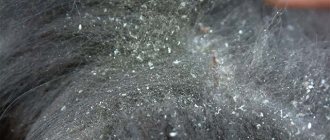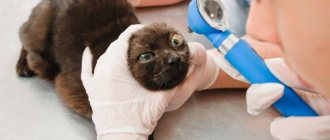Plasmacytic pododermatitis and its causes
Etiological factors that could provoke the disease have not been identified. During laboratory examination, an increase in serum globulin concentrations and the presence of lymphocytosis are noted. When plasma cells are involved and immune complexes are deposited in the skin, experts speak of an immune-related disease.
An increase in the concentration of plasma cells and the volume of granulation tissue gives the clinical picture in the form of poorly limited swelling of the fingertip. Constant contact with the floor (ground) leads to damage to the epidermis, its ulceration, and the penetration of bacterial microflora leads to the development of a secondary infection.
Injuries in cats
Cats often fall from heights and are injured. Many ordinary people tend to consider a broken limb to be the most “terrible” of such injuries, but in fact, fractures in cats are well treated, and the animal has every chance of making a full recovery. True, fractures are also different. For example, an animal may suffer an intra-articular fracture, in which a crack runs along the surface of the “hinge” of the joint. Such fractures are the most complex, they require long-term treatment and sometimes lead to the development of arthrosis.
Very often, after a fall, the animal begins to drag its hind legs. This may be a sign not so much of paw fractures as of some kind of neurological injury, for example, a fracture of the spinal column. It occurs quite often in cats, and most often occurs at the level of the last thoracic and first lumbar vertebrae. Such a fracture is fraught with serious injury to the spinal cord and, unfortunately, the prognosis in this case is unfavorable.
The animal needs to be shown to a veterinarian as quickly as possible if:
- the cat does not eat or drink;
- limps heavily, does not support a limb;
- The cat developed bloody saliva, bloody discharge from the nose, and blood in the urine.
If the animal feels well, eats and drinks normally, but has a slight limp, then the owner may not rush to visit the doctor. Perhaps the cat just has a sprain or bruise that goes away quickly without treatment. But if lameness does not go away within a few days, then it is better to contact a veterinary clinic.
A rupture of the spinal cord may be indicated by the absence of pain. This is easy to check even at home. You need a suitable tool, such as tweezers, to squeeze the skin between the toes of the hind paw quite firmly. In a normal situation, such manipulation will cause pain - the cat will scream, try to scratch or bite. In this case, the prognosis will be favorable. But if the animal does not react in any way to such pain, then, most likely, its spinal cord is seriously injured. Even if the cat jerks its paw when squeezed, this does not mean anything. This is how the flexion reflex manifests itself, which can persist even with a complete rupture of the spinal cord. In case of spinal injury, only the feeling of pain can be considered a favorable factor that gives the animal a chance to recover.
Often, injuries associated with a fall from a great height lead to rupture of the diaphragm (the so-called partition between the chest and abdominal cavities). When it ruptures, part of the internal organs of the abdominal cavity, in particular the intestines and liver, can move into the chest cavity, where the lungs are located. Externally, such damage is expressed in the fact that the animal develops rapid breathing and cyanosis of the mucous membranes, because the lungs can no longer fully expand. The cat loses its appetite, and due to the pain caused by the injury, stiffness appears in its movements. But an accurate diagnosis can only be made using radiographic examination. If the diaphragm ruptures, the animal requires surgery, which can only be performed in a veterinary clinic.
Signs of the disease: what can be noticed during examination
When observing such cats at the RosVet VC, the veterinary dermatologist does not note strict age and breed characteristics. This means that plasmacytic pododermatitis can occur in any pet; it is impossible to predict the disease.
Mainly one central pad on the paw is affected, but it is also possible that several toe pads will be involved in the pathological process.
Clinical picture:
- the formation of a soft, painless swelling;
- hyperkeratotic, alternating stretch marks of the skin on the fingers;
- the color changes from pinkish (dark) to pale blue with a purple tint.
When the pad is ulcerated, granulation tissue begins to protrude and local lymphadenopathy is observed. For a cat, plasmacytic dermatitis in the initial stages does not cause severe discomfort, there is no pain, so the owner of the animal does not always notice the first clinical signs.
Cats with plasmacytic pododermatitis have not been associated with carriage of the leukemia virus or immunodeficiency virus. Very rarely, along with swelling of the pads, the back of the nose may also swell.
Subtle symptoms of chlamydia
Manifestations of chlamydia, or rather, their frequent absence, make a significant contribution to the successful spread of the disease. In approximately 50% of men and 80% of women, the infection occurs latently, without causing changes in well-being. It can be said that the minority who develop characteristic symptoms are the lucky ones who have the chance to quickly identify and treat an insidious disease.
In men, chlamydia is manifested by discharge from the urethra, pain in the lower abdomen, swelling of the scrotum and urinary disorders. Female chlamydia is characterized by:
- discharge from the vagina and urethra;
- abnormal bleeding;
- pain and bleeding after sexual intercourse;
- lower abdominal pain;
- urinary disorders.
The asymptomatic majority, not diagnosed and untreated in a timely manner, have many chances to experience all the insidiousness of chlamydia.
Diagnosis and differentiation from similar pathologies
An accurate clinical picture and laboratory tests help make the correct diagnosis. Biopsy material is taken and examined histologically. Plasma cells are found in stained fingerprint smears.
There is practically no need to differentiate plasmacytic pododermatitis; its clinical picture is unique. But just in case, fungal, bacterial, collagenolytic granuloma, and squamous carcinoma can be excluded. Conducting a study for calicivirus and herpesvirus infection of cats.
Diagnosis of diseases
Having become familiar with the most common causes of epidermal diseases, the owner must be prepared all the time and know what to do if a problem arises . First of all, the owner is obliged to provide the pet for examination by a doctor so that the veterinarian can draw up an opinion on how likely it is to develop a certain disease.
Diagnosing any skin disease is quite difficult. A lot here depends not only on the veterinarian, but also on the information that the cat’s owner provides during the examination. It is also necessary to take into account that a number of studies and analyzes need to be carried out. They will be able to help achieve the desired indicators and identify the exact nature of the disease.
Diagnostics will help to create a clear treatment plan, identify the dangers of the disease and the degree of contagiousness . Therefore, you should not ignore the opportunities that provide you with professional and specialized treatment assistance.
Plasmacytic pododermatitis and its treatment
An exact treatment regimen for the disease has not been developed. There is information about the successful use of doxycycline (5 mg/kg by mouth every 8 hours. Course 1-2 months). Systemic antibiotics, glucocorticosteroids, and chlorambucil have proven themselves to be quite effective. Sometimes the affected pad is surgically removed using chrysotherapy and dressings. But, unlike doxycycline, all other methods do not provide a permanent effect.
If you notice that your cat’s paw pads have changed their configuration and color, areas of ulceration have appeared, or suppuration has begun, don’t hesitate! Call the RosVet VC by phone. You can make an appointment with a veterinary dermatologist 24 hours a day.
Causes
Obviously, the most common causes of swollen paws in cats are usually related to the cat's environment. This could be the result of an insect bite, an allergic reaction, injury, or infection.
© shutterstock
Injury
Trauma to a cat's paw can appear as cuts and abrasions if they step on something sharp, or as blisters from walking on a hot surface, such as a sidewalk. A cat can also be injured by a foreign object lodged in a paw pad or between its toes, such as a splinter, small nail, glass shard, or hangnail.
Cats can even suffer from broken bones, including a broken toe. Most often, a broken toe occurs when a cat grabs something with its claw and then forcefully pulls it out. This can damage the finger and cause a fracture and, in some cases, a sprain.
It is impossible to predict what dangers your cat may be exposed to in everyday exploration. Trauma can happen anywhere, anytime. Sometimes cats can even get paw injuries from their relatives.
This is because when cats play together, they tend to use both their teeth and claws, making biting and scratching common. This means they can get hurt by their playmates or other cats who are not as friendly, initiating a fight. Or they might get bitten by a squirrel or small rodent they were playing with. The possibilities are endless!
You should also remember that most cats are jumpers and climbers. This means that fractures, sprains and dislocations are quite common. Not to mention, cats love to curl around their humans' legs and get under their feet, especially when they're hungry or want attention.
This makes them a prime candidate for accidentally stepping on one of those little paws. In addition, for some reason, street cats love to lie under cars and play in wheel arches. It may be dangerous. They may have accidentally crushed their paw under the tire because they weren't moving fast enough to get out from under it when it started moving.
Allergic reactions
Cats are not immune to allergens either. You might think that they are often the cause of allergies in cats, and sometimes this is true for us humans. But cats can also suffer from cat allergies.
Allergies can affect your cat in a variety of ways, including swollen paws, itching, runny nose, feline digestive problems, and more. The allergy can be a reaction to something in their environment, and sometimes to something on the carpeting or in the grass in the yard.
Sometimes reactions occur due to cat food allergies, and sometimes they can be a reaction to an insect or bee sting. Regardless of the cause, any type of allergic reaction can cause your cat to chew, bite, and lick its paws, especially if they are itchy.
Excessive licking will cause swelling and further inflammation in cats. It may even progress to scabs and hair loss, further aggravating the situation. In some cases, such as bee stings, a cat can go into anaphylactic shock, a life-threatening allergic reaction that relies on a quick response. This is one reason why it's important not to ignore it if you notice that one of your cat's paws looks swollen, especially if you suspect something has stung or bitten her.
Complications from ingrown toenails and their removal
Sometimes a cat's paw (or paws) become swollen due to ingrown claws that grow and curl into your cat's paw pad. It pierces the delicate skin of the pad, causing pain, inflammation and, in many cases, infection. Although this problem is more common in older cats, it can happen to any cat of any age if you don't take care of their nails and trim them when necessary.
Typically, if they have scratching posts, a cat's claws will remain at a healthy length. But sometimes there may be an underlying medical condition that causes the nails to become overgrown. If this happens frequently, it is best to contact your veterinarian to rule out anything more serious.
Abscesses
Some cats may develop abscesses that affect the feet. These abscesses may appear as round, warm, hard lumps under the skin, causing the cat's paws to swell. Because the abscess is filled with infection, it will produce a foul-smelling discharge when it finally bursts. Try not to let your cat lick the boil. This will only make the infection worse and possibly cause it to spread.
Tylenol toxicity
Sometimes your pet may experience swollen paws as a side effect of cat poisoning, especially with medications such as Tylenol (sometimes called acetaminophen). When they have ingested toxic levels of this drug, fluid may accumulate in their paws. You should contact your veterinarian immediately if you suspect your cat is poisoned because she may require supportive care such as fluids and oxygen, among other treatment measures.
© shutterstock
Pododermatitis
Another common cause of paw swelling in cats is a condition called pododermatitis. The swelling is limited to the paw pad, giving it a soft appearance.
If the condition is mild, it may not bother your cat too much. However, as the condition progresses, your cat's paw may become even more swollen, bruised, and painful sores may appear. Over time, the paw pad can crack, forming painful ulcers that will require treatment to avoid infection.
Pododermatitis is essentially a condition of severe inflammation that affects your cat's paw pad. Very rarely, only one foot is affected. In most cases, they all become inflamed. Pododermatitis is thought to be the result of the cat's immune system mistakenly producing an excess of lymphocytes.
These lymphocytes collect in your cat's paw pad. This set of lymphocytes then causes the antibodies to attack perfectly healthy paws, causing swelling and pain.











